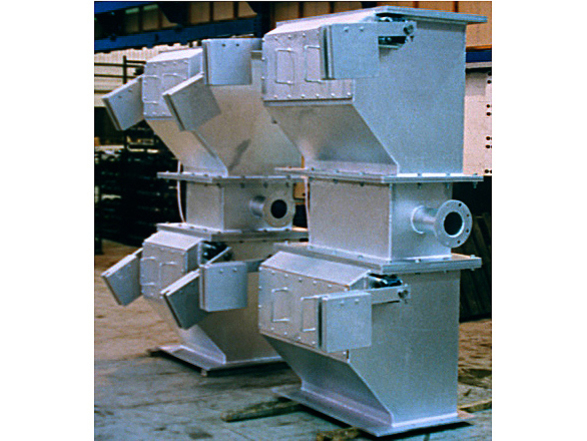European Gate Valves have completed a number of contracts for the supply of their double flap valves for use on Roadstone Coating Plants, due to better performance compared to rotary valves.
Main area of application for Double Flap Valves is as a Rotary Valve replacement when they are used on the conveying system for fines/filler from the bag filter. The bag filter is situated downstream from the aggregate drier and dust loads can be quite high.
Not all plants use pneumatic conveying systems for moving the filler from the bag filter to the storage silos. Where they are used the problems of leakage and environmental spillage can be severe. Plants have been threatened with action from the environmental agency for such discharges.
Typical wear rates on Rotaries can result in valve change out between 2 months and a year depending on the nature of the material from the bag filter. Double Flap Valve replacement of internals vary from 3 years to about 8 years. The benefit costs can therefore be considerable.
The Double Flap Valve is taller than the rotary for any given capacity. This can be a problem but in many cases with minor changes to chutes and discharge positions a lot can be accomplished. Some plants have the valve situated on platforms and by simply moving the conveying pipe to under the platform the height of the Double Flap Valve can be accommodated. Similarly one plant was prepared to dig a hole under the rotary to allow replacement and sweep the conveying pipe in.

Most of the spillage has blown out of the end seals

This drawing shows the kind of adjustments that can be made to install a valve. European Gate Valves went on site and accurately measured up the existing rotary valve installation and presented the above proposed installation drawing.

Some plants have a complex arrangement of chutes and blowing lines due to several destinations for the filler.
Double Flap Valves can overcome most of the problems associated with rotary valves.
The wiping action of the rotary valve inevitably wears the valve casing and increases leakage. The leakage can results in loss of operational efficiency in the process or severely damage upstream equipment. Expensive repairs to rotary valves require the complete removal of the valve from the process.
Double Flap Valves have no wiping actions, leakage is therefore negligible and does not get appreciably worse with use and all wear components can be changed with the valve in-situ.
This FL-300 (Fabricated, Low Height, 300mm) at a London Asphalt Plant shows the typical layout where the PLC is mounted on the valve
The double flap valves are robustly manufactured to suit a wide range of application requirements:
Valve Bodies can be made in: Cast Iron, Cast High Nickel Chrome and Cast Aluminium
Fabricated bodies made in Carbon steel or Stainless Steels
High chrome alloy seats and flaps provide long life even in the most aggressive applications
Range of Applications
Temperatures to 1000°C
Differential pressures to 102 Kpa where positive is below
Abrasiveness - Some of the most abrasive materials are comfortably handled
Lump Size - Depends on the valve opening size
Opening to 600mm square
Range of actuators
Linear Pneumatic Cylinders
Rotary Pneumatic Cylinders
Electric Motor with cams or push rods
Gravity or Manual
Hydraulic
Features
Dual access covers
Outboard Bearings
Adjustable packed shaft seals as standard
VDMA ISO standard cylinders
Removable seat and flap with the valve in situ
All metric standard components
Wide range of optional equipment
PLC Control
Flap position indication
Heat shields
Cooling for high temperature applications
Purged high efficiency shaft seals






